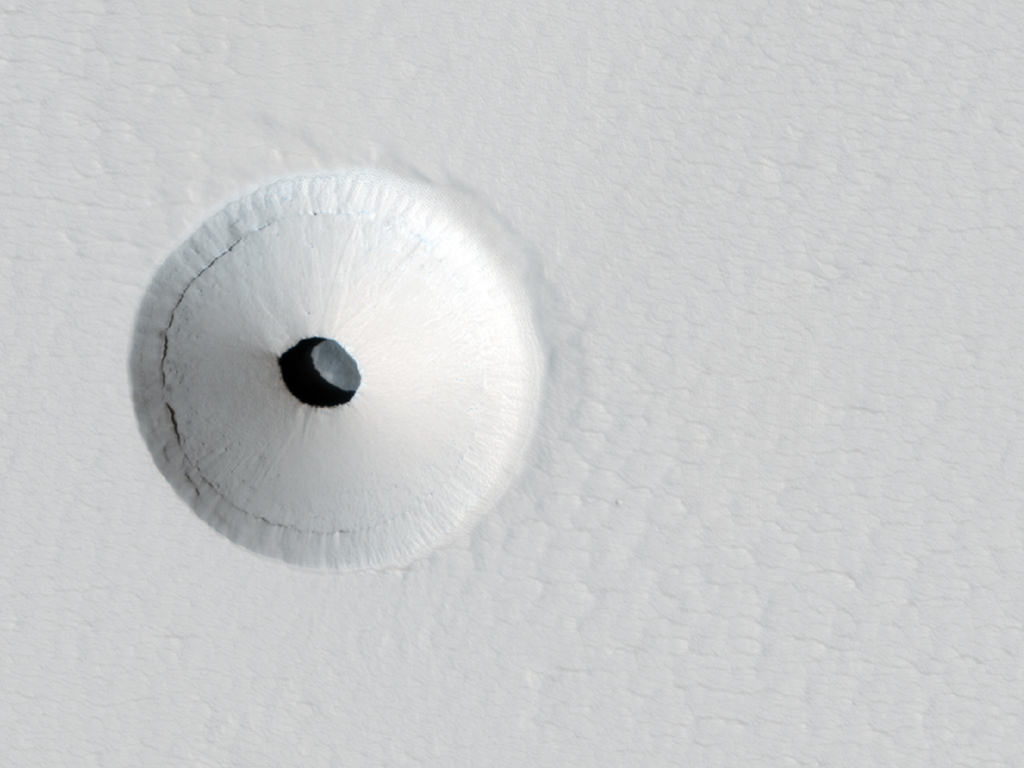[/caption]
What would make a great home for a giant Martian ant lion? I’d have to say this pit, imaged by the HiRISE camera aboard the Mars Reconnaissance Orbiter!
Earlier this year a crater was spotted with a dark spot at its center. When the team took a closer look with the high-resolution camera they saw that the spot is actually a 35-meter (115-foot) -wide skylight that opens into an underground cavern. The cavern is most likely a section of an empty lava tube, leftovers from ancient Martian volcanic activity.

Based on the shadows it’s estimated that the pit is about 20 meters (65 feet) deep. But, how much of that is material piled up on the floor of the cavern from the surrounding crater itself? And what caused the crater to form in the first place? These are questions that remain to be answered.
The HiRISE image itself is false-color, the hues denoting the texture and composition of the surface material and not the actual color as would be seen in visible light.
As far as a giant Martian ant lion… well, unless there are some giant Martian ants around for it to snack on, I’m going to assume there’s nobody home!
Image credit: NASA / JPL / University of Arizona.


As that context (“ants”) is plural, it should be there are, not “there’s”.
In the same sentence, there should be a comma after ‘on’.
Yep.
Sooo if we sent humans to Mars and needed a base site safe from the 300mph winds in storms….inner inflatable roof to keep heat in
I suspect that it’s actually a giant pinhole camera. Mars is watching us. This comment brought to you by the fantasies of Richard Hoagland
It’s too bad there aren’t any lava tubes within easy reach of Opportunity. Finding one for Oppy to drive into could be a gold mine of “opportunity” to find microbial life underground, without having to dig down for it. Maybe Curiosity could find one next year near its landing site too.
It would have to be a very special design of rover to be able to climb down into a hole like that. Current rovers aren’t up to the task, and it’s far too much of a risk… it’s dicey enough just clambering over pebbles!
Which is why we need a manned mission. There are a couple of cars on the moon that pebbles did not stop. With a winch on the bumper and some spade anchors, an explorer could repel down. We can all watch when Space x does it.
well, my immediate question would be how to test if this “construction” will collapse if weight is applied to the slopes… otherwise the perfect hideout for the new variety of ‘Martians’.
Instant colony – Cover, pressurize, add water.
It sounds simple but really it’s quite a significant engineering challenge.
Without knowing the structure of the rock, we can’t say that pressurizing it won’t blow the structure apart. We can’t say there aren’t going to be any leaks anywhere throughout the cave system without thorough testing. Air might even leak through the rock itself. Welding a “door” to the entrance is not going to be easy by any means – it has to be airtight. You’d have to know in advance the exact shape of the entrance and take a door to fit – you couldn’t just engineer one after getting there. And it couldn’t just be a door – you’d have to fit an airlock too.
There may be issues with transmitting data through to rock to satellites. There may be issues with poisonous gases leaking in from surrounding rock, or fine dust that could cause respiratory problems (and affect electronics). Marsquakes would have to be accounted for – they may be rare but just one small one could lead to catastrophic decompression.
It would be cheaper, easier, and far less risky to take an artificial habitable compartment. There are far fewer unknowns involved.
Depending on the size of the cavern below, however, it might make a good site to put such a habitat in assuming an entry/exit can be reasonably fashioned.
Totally cool. I love this site.
Why do they jump to the conclusion it’s a ‘lava tube’ when there are no lava flows on Mars at all ?
The cavern might be a place where a habitat could be placed.. I have heard of ideas like this with respect to the moon. This would be a way of shielding a habitat from space radiation, which is lethal on the Martian surface. Yet it would be quite a job getting that to Mars, along with the crane equipment required to lower it into this cave. It is not going to happen any day really soon.
LC
Perhaps an inflatable system could be used to blow out a ballon-like habitat within the lava tube. The module itself could potentially be loaded with inflatable bags, possibly allowing it to just “roll into” the cavity, no?
These schemes would be very difficult to work. I think one problem is that we are too influenced by science fiction. The Hubble repair missions are case in point. If the HST had been on the ground the repairs would have been rather simple. The repair in space with suited astronauts was a highly complex task. Performing complex tasks on the moon or Mars would similarly be very difficult. Also difficulty translates into expensive. The next mars rover MSL’s Curiosity will execute a crane type of landing. This is going to be a bit of a nail biter, and none of this came cheap — about $2.5 billion.
LC
Crane? Use a balloon or a rocket skycrane.
There are many lava flows on Mars. Here’s a look at a few: http://www.esa.int/SPECIALS/Mars_Express/SEM5TDF280G_0.html
Mars has no active volcanoes or lava flows at the present time; however, in the early history of Mars, it was most certainly volcanically active, as evidenced by the largest known extinct volcano in the Solar System: Olympus Mons.
Mars has no active volcanoes or lava flows at the present time; however, in the early history of Mars, it was most certainly volcanically active, as evidenced by the largest known extinct volcano in the Solar System: Olympus Mons.
Does anyone have coordinates for this so I can look for it on google mars?
Latitude (centered): 3.7 degrees – Longitude (East): 248.5 degrees
More info :
Caves and Craters